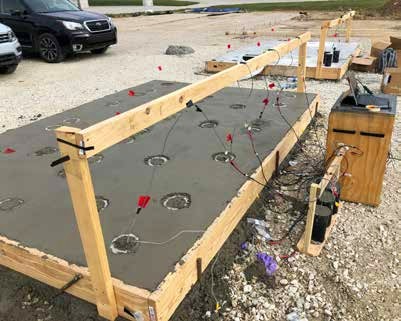An Eco-Friendly Upgrade
Alternative cement produces stronger, more environmentally sustainable concrete
Purdue Civil Engineering researchers are testing a greener, more durable concrete.
Concrete is an essential material in the developed world, but its production is also one of the biggest emitters of carbon dioxide. Na (Luna) Lu, American Concrete Pavement Association professor of civil engineering, is testing a new cementitious material that appears to be more durable than standard concrete and has a significantly smaller carbon footprint.
The key component of this cementitious material is suspended liquid nano silica — more commonly called E5 LFA (liquid fly ash). In the testing thus far, the concrete mixed with E5 LFA has shown to produce a stronger, better-reacting concrete that requires 5-15 percent less cement to produce.
“Less cement used means less carbon dioxide created,” Lu said. “This new use of liquid nano silica as a fly ash replacement has shown great potential to improve both future projects and the environment overall.”
Lu’s team began their large-scale research in early 2020 in partnership with Specification Products, an Indiana-based liquid nano silica manufacturer.
“We’re excited about the future and what E5 LFA can bring to concrete,” said Joe Shetterley, CEO of Specification Products. “The research being done at Purdue will grant us a greater understanding of the material’s strength and potential.”

Lu’s team conducted a large-scale slab testing project to understand the in-situ concrete strength development using different approaches for obtaining samples, including conventional molded cylinder, cast-in-place sample and a core sample. The 8-by-12-foot slabs were prepared at Purdue’s Center for Aging Infrastructure to simulate the practical construction of concrete pavement. The researchers tested various ages of concrete slabs including some recently poured and others left for one year for long-term monitoring.
The project is focused on adopting the emerging piezoelectric sensing technology developed by Lu’s research team to monitor the material’s hydration development and long-term performance.
“We’re still in the early stages of testing, but it is exciting to see how well the concrete has held up,” Lu said. “To date, liquid nano silica has never been used to replicate the positive effects of fly ash to my knowledge, so we’re all learning a great deal.”
Members of Lu’s research team included civil engineering undergraduates Harrison Kuszmaul and Songhao Wu. Both students said the experience greatly expanded their theoretical and experimental skills.
“This was an incredible opportunity for me,” Kuszmaul said. “To be part of large-scale research team and see how, exactly, what I’ve learned in class is applied was an eye-opening experience for me.”
“Seeing what we’ve studied applied to research like this gave me some great experience that I couldn’t have gotten anywhere else,” Wu added. “Being part of the research team really helped me discover my passion.”
Testing and research will continue through 2022, Lu said.

